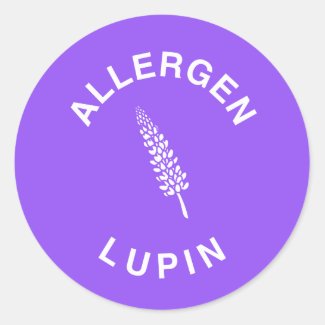Lupine (also spelled lupin) is one of the 14 major food allergens—yet it often goes unnoticed. Its use in modern food manufacturing is increasing because it's rich in proteins, fatty acids, and dietary fiber. As a plant-based ingredient, it’s becoming popular as a meat substitute thanks to its complete amino acid profile. But for people with lupin allergy, this seemingly healthy legume can trigger serious and even life-threatening reactions.
What Is Lupin or Lupine?
Lupin (or lupine) belongs to the legume family, making it a relative of peanuts, soybeans, and lentils. In food manufacturing, it’s often used in the form of lupine flour or bean flour and appears in various processed products such as:
- Breads, Pastries, and Cakes
- Breaded Products and Snacks
- Sauces, Vinaigrettes, and Soups
- Chocolate, Sweets, and Desserts
- Vegetarian and Vegan Meat Substitutes
- Cold Cuts and Processed Meats
Why Lupine Is Becoming a Common Allergen
Approximately 40% of people with a peanut allergy also react to lupin due to cross-reactivity between the two legumes. As the use of lupin in gluten-free and vegetarian foods grows, cases of lupin food allergy are becoming more common worldwide.
Symptoms of Lupin Allergy
For sensitive individuals, even a small amount of lupin can trigger a variety of allergic symptoms. These reactions can range from mild discomfort to severe, life-threatening anaphylaxis.
1. Respiratory Reactions
- Asthma and Wheezing: Difficulty breathing, coughing, or tightness in the chest.
- Choking and Throat Swelling: In severe cases, swelling in the throat may obstruct breathing—seek emergency care immediately.
2. Skin Symptoms
- Rashes and Hives: Itchy, red bumps appearing shortly after exposure.
- Itchy Mouth or Lips: Tingling and irritation after consuming food containing lupine.
3. Swelling and Edema
- Facial Swelling: Puffiness around the eyes, lips, or face.
- Angioedema: Deep tissue swelling, sometimes affecting the airways.
4. Anaphylaxis
The most severe form of allergic reaction, anaphylaxis, is a medical emergency that can cause:
- Sudden drop in blood pressure
- Lightheadedness or fainting
- Rapid pulse
- Nausea, vomiting, or abdominal pain
If you experience difficulty breathing or throat swelling after eating food that may contain lupin, call emergency services immediately.
Cross-Reactivity Between Lupine and Other Allergens
Lupin shares similar proteins with other legumes, especially peanuts. This means that people allergic to peanuts, soy, or chickpeas might also be sensitive to lupin. Always consult an allergist before consuming new plant-based products if you have a known legume allergy.
How to Identify Lupin in Food Labels
Detecting lupin in processed foods can be tricky because it may appear under various names. Always read labels carefully and look for terms such as:
- Lupine
- Lupin Flour
- Lupinus
- Lupini Beans / Tremocos
- Lupin Protein Concentrate
- Okara
- Dietary Fiber (Plant-Based)
Hidden Sources of Lupin in Everyday Foods
Lupin may be used to improve texture and nutrition in foods where you least expect it. Watch out for it in:
- Pastries and Cakes
- Waffles and Pancakes
- Pasta and Pizza Dough
- Vegetarian Meat Alternatives
- Protein Bars and Shakes
Lupin Allergy Diagnosis and Treatment
If you suspect a lupin allergy, see a certified allergist for testing. Diagnosis usually involves skin prick tests or specific IgE blood tests. Once diagnosed, strict avoidance of foods containing lupine is essential. Individuals with a history of severe reactions should carry an epinephrine auto-injector (EpiPen) and inform friends, family, and restaurants about their allergy.
Read also: Xolair: New Hope for Food Allergies
Final Thoughts: Although lupin allergy is less known, it can be just as dangerous as peanut or shellfish allergies. Awareness, accurate labeling, and education are key to protecting those affected.



